Particle Swarm Optimization Based on Local Attractors of Ordinary Differential Equation System
Abstract
Particle swarm optimization (PSO) is inspired by sociological behavior. In this paper, we interpret PSO as a finite difference scheme for solving a system of stochastic ordinary differential equations (SODE). In this framework, the position points of the swarm converge to an equilibrium point of the SODE and the local attractors, which are easily defined by the present position points, also converge to the global attractor. Inspired by this observation, we propose a class of modified PSO iteration methods (MPSO) based on local attractors of the SODE. The idea of MPSO is to choose the next update state near the present local attractor, rather than the present position point as in the original PSO, according to a given probability density function. In particular, the quantum-behaved particle swarm optimization method turns out to be a special case of MPSO by taking a special probability density function. The MPSO methods with six different probability density functions are tested on a few benchmark problems. These MPSO methods behave differently for different problems. Thus, our framework not only gives an interpretation for the ordinary PSO but also, more importantly, provides a warehouse of PSO-like methods to choose from for solving different practical problems.
1. Introduction
Inspired by sociological behavior associated with bird flock, particle swarm optimization (PSO) was first introduced by Kennedy and Eberhart [1]. In a PSO, the individual particles of a swarm fly stochastically toward the positions of their own previous best performance and the best previous performance of the swarm. Researchers have been trying to excogitate new framework to interpret PSO in order to analyze the property of PSO and to construct new PSO-like methods. For instance, in [2] PSO is interpreted as a difference scheme for a second-order ordinary differential equation. Fernández-Martínez et al. interpret PSO algorithm as a stochastic damped mass-spring system: the so-called PSO continuous model and present a theoretical analysis of PSO trajectories in [3]. Based on a continuous vesion of PSO, Fernández Martínez and García Gonzalo propose Generalized PSO(GPSO) in [4] and introduce a delayed version of the PSO continuous model in [5]. Furthermore, Fernández-Martínez and García-Gonzalo give stochastic stability analysis of PSO models in [6] and propose two novel algorithms: PP-GPSO and RR-GPSO in [7]. PSO algorithms have been applied successfully for practical applications [8–10].
In [11], a so-called quantum-behaved particle swarm optimization (QPSO) is proposed based on an assumption that the individual particles in a PSO system have quantum behavior. A wide range of continuous optimization problems have been solved successfully by QPSO and many efficient strategies have been proposed to improve the algorithm [11–20]. A global convergence analysis of QPSO is given by Sun et al. in [21].
In this paper, we interpret PSO as a finite difference scheme for solving a system of stochastic ordinary differential equations (SODE in short). In this framework, the convergent point of the position points in the PSO iteration process corresponds to an equilibrium point (a global attractor) of the SODE. We observe that the local attractors, which are easily computed by using the present position points, also converge to the global attractor in the PSO iteration process. Inspired by this observation, we propose a class of modified PSO iteration methods (MPSO in short) based on local attractors of the SODE. The idea of MPSO is to choose the next update state in a neighbourhood of the present local attractor, rather than the present position point as in the original PSO, according to a given probability density function. We will test the MPSO methods with six different probability density functions for solving a few benchmark problems. These MPSO methods behave differently for different problems. Thus, our framework not only gives an interpretation for the ordinary PSO but also, more importantly, provides a warehouse of PSO-like methods to choose from for solving different practical problems.
Our work is partly inspired by the second-order ordinary differential equation framework for PSO in [2, 3]. But the solution of a second-order ordinary differential equation is somehow more difficult to describe and it seems more difficult to construct new PSO-like methods through this framework. Our framework of ordinary differential equation makes the job easier.
Our work is also inspired by the quantum-behaved particle swarm optimization (QPSO) method in [11]. It turns out that QPSO becomes a special case of our MPSO by choosing a special probability density function. And fortunately, the convergence analysis for QPSO given in [21] is still valid for our MPSO methods. In fact, what matters in the convergence analysis is a suitable choice of the probability density function, and the particular quantum behavior does nothing in the convergence analysis.
The rest of the paper is organized as follows. In Section 2 we interpret PSO as a system of ODE and propose a class of MPSO methods. Then, in Section 3 we test, on some nonlinear benchmark functions, our MPSO methods with different probability density functions. Finally, some conclusions are gathered in Section 4.
2. Particle Swarm Optimization Algorithms
2.1. The Original PSO
2.2. Interpretation of PSO as a Finite Difference Scheme for an SODE
2.3. MPSO for Iteratively Decreasing
Now, let us forget the original PSO and concentrate on the task of finding a global attractor (an equilibrium point) of the SODE (7). Based on (10), we see that finding an equilibrium point of the ODE system (7) is equivalent to making the position vector closer and closer to the local attractor . Thus, we choose the next update state in a neighbourhood of the present local attractor, rather than the present position point as in the original PSO, according to a given probability density function (PDF).
Our MPSO algorithm is described in detail in Algorithm 1.
-
Algorithm 1
-
Choose a PDF Q(Y; L).
-
Initialize population position vector X
-
Do
-
For i = 1 to population size M
-
If f(Xi) < f(Pi) Then Pi = Xi
-
End For
-
-
-
For i = 1 to population size M
-
For j = 1 to dimension N
-
Choose α and compute .
-
Choose a random number ,
-
according to the PDF .
-
Choose , .
-
If rand(0,1) > 0.5 Then
-
If rand(0,1) < 0.5 Then
-
End For
-
End For
-
Repeat the iteration until all the increments are small enough
-
or some other termination criterion is satisfied.
2.3.1. MPSO with Different PDFs
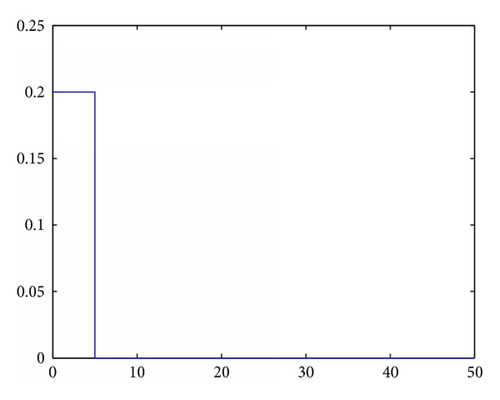
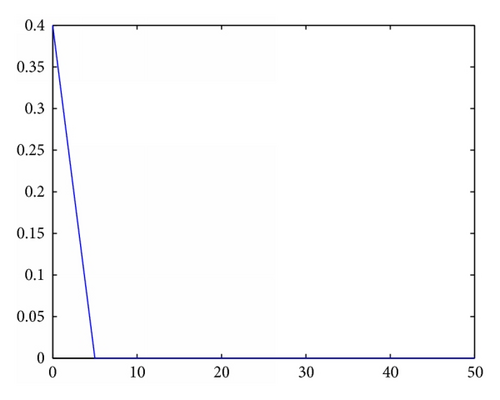
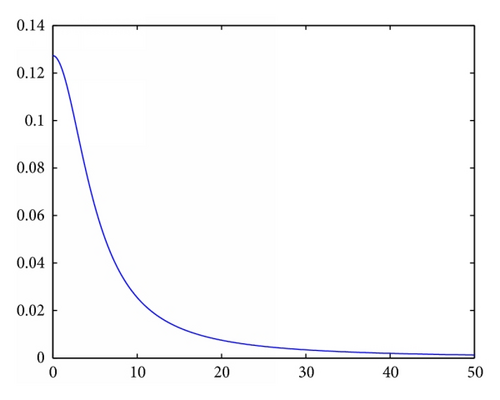
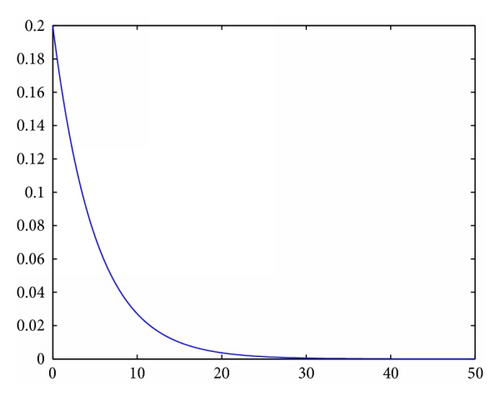
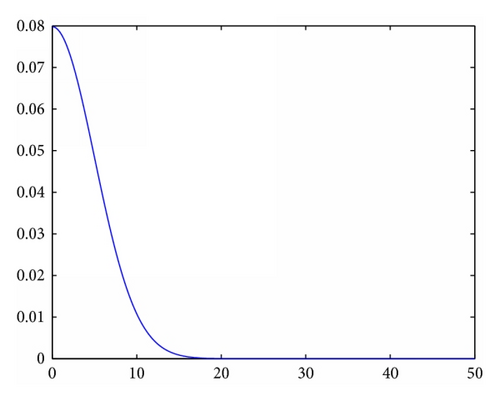
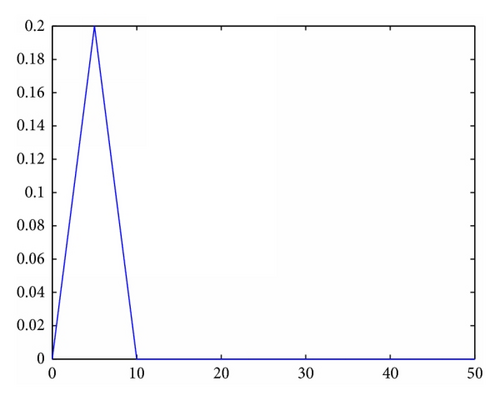
2.4. Quantum-Behaved Particle Swarm Optimization
Let us elaborate a little bit on QPSO. In [11], Sun et al. assume that, at the nth iteration, on the jth dimension (1 ≤ j ≤ N) of the search space, particle i moves in a δ potential well centered at which is the jth dimension coordinate of its local attractor.
3. Numerical Simulation
| Function | Asymmetric initialization range | Search range |
|---|---|---|
| Sphere | (50,100) n | [−100,100] n |
| Rosenbrock | (15,30) n | [−100,100] n |
| Genralized Rastrigrin | (2.56,5.12) n | [−10,10] n |
| Genralized Griewank | (300,600) n | [−600,600] n |
| Schaffer | (30,100) n | [−100,100] n |
As in [11], different population sizes (20, 40, and 80) are used for each function to investigate the scalability. The maximum number of the generations is set to 1000, 1500, and 2000, corresponding to the dimensions 10, 20, and 30 for the four functions, respectively. The mean best fitness values and standard deviations, out of total 50 runs of MPSO with different PDFs on f1 to f5, are shown in Tables 2, 3, 4, 5, and 6. In the tables, α is the parameter in (12), and α = 1 → 0.5 means that α decreases linearly from 1 to 0.5. The boldface results are obtained by performing the QPSO algorithm in [11], which is equivalent to MPSO with the PDF Q5. An efficiency comparison of MPSOs with different PDFs on f1 to f5 is presented in Table 7.
| Dim. | Gmax | M = 20 | M = 40 | M = 80 | ||||
|---|---|---|---|---|---|---|---|---|
| Mean best | Standard deviation | Mean best | Standard deviation | Mean best | Standard deviation | |||
|
10 | 1000 | 9.76E − 25 | 1.77E − 24 | 1.31E − 27 | 7.55E − 27 | 2.58E − 30 | 1.70E − 29 |
| 20 | 1500 | 9.71E − 13 | 2.71E − 12 | 2.26E − 16 | 4.45E − 16 | 1.18E − 20 | 2.35E − 20 | |
| 30 | 2000 | 8.36E − 07 | 1.21E − 06 | 2.65E − 09 | 3.76E − 09 | 1.59E − 12 | 2.94E − 12 | |
|
10 | 1000 | 1.24E − 32 | 8.66E − 32 | 3.32E − 62 | 2.14E − 61 | 9.67E − 88 | 4.14E − 87 |
| 20 | 1500 | 3.16E − 17 | 2.21E − 16 | 1.96E − 35 | 1.35E − 34 | 4.82E − 50 | 2.78E − 49 | |
| 30 | 2000 | 4.15E − 12 | 1.99E − 11 | 1.24E − 24 | 5.66E − 24 | 3.57E − 36 | 2.32E − 35 | |
|
10 | 1000 | 4.36E − 19 | 1.77E − 18 | 4.05E − 28 | 2.83E − 27 | 7.77E − 40 | 5.41E − 39 |
| 20 | 1500 | 1.28E − 08 | 4.99E − 08 | 1.07E − 15 | 3.57E − 15 | 2.86E − 22 | 1.20E − 21 | |
| 30 | 2000 | 4.69E − 05 | 1.06E − 04 | 4.73E − 10 | 9.70E − 10 | 2.58E − 14 | 9.63E − 14 | |
|
10 | 1000 | 9.65E − 24 | 6.65E − 23 | 8.46E − 38 | 5.87E − 37 | 1.47E − 49 | 7.85E − 49 |
| 20 | 1500 | 7.37E − 14 | 4.02E − 13 | 3.33E − 22 | 6.45E − 22 | 4.30E − 29 | 1.27E − 28 | |
| 30 | 2000 | 1.31E − 07 | 5.47E − 07 | 2.58E − 10 | 1.80E − 09 | 3.76E − 18 | 1.20E − 17 | |
|
10 | 1000 | 1.18E − 27 | 6.19E − 27 | 8.47E − 40 | 5.82E − 39 | 8.09E − 53 | 5.23E − 52 |
| 20 | 1500 | 1.16E − 14 | 4.48E − 14 | 1.47E − 23 | 7.46E − 23 | 1.04E − 31 | 3.46E − 31 | |
| 30 | 2000 | 7.16E − 09 | 4.01E − 08 | 2.73E − 16 | 6.02E − 16 | 9.68E − 22 | 3.07E − 21 | |
|
10 | 1000 | 1.98E − 29 | 1.39E − 28 | 3.91E − 51 | 2.56E − 50 | 1.24E − 64 | 8.50E − 64 |
| 20 | 1500 | 4.43E − 18 | 1.43E − 17 | 2.23E − 28 | 6.62E − 28 | 2.37E − 38 | 9.78E − 38 | |
| 30 | 2000 | 2.82E − 11 | 1.06E − 10 | 2.12E − 19 | 8.70E − 19 | 1.31E − 26 | 4.29E − 26 | |
| Dim. | Gmax | M = 20 | M = 40 | M = 80 | ||||
|---|---|---|---|---|---|---|---|---|
| Mean best | Standard deviation | Mean best | Standard deviation | Mean best | St andard deviation | |||
|
10 | 1000 | 17.9685 | 29.8452 | 12.2590 | 21.7814 | 11.7597 | 26.2940 |
| 20 | 1500 | 111.6378 | 188.7111 | 60.2500 | 50.6469 | 46.2081 | 41.0317 | |
| 30 | 2000 | 416.5972 | 1436.0 | 112.4362 | 145.4795 | 72.8064 | 99.0574 | |
|
10 | 1000 | 33.6155 | 49.8280 | 26.2646 | 43.4507 | 8.2692 | 9.3772 |
| 20 | 1500 | 82.0246 | 67.5004 | 60.3972 | 51.3739 | 44.3745 | 42.1392 | |
| 30 | 2000 | 138.9158 | 138.7761 | 83.9015 | 80.3806 | 68.5438 | 42.1898 | |
|
10 | 1000 | 17.2888 | 36.1287 | 16.5371 | 31.0729 | 11.9782 | 26.6798 |
| 20 | 1500 | 89.6570 | 162.4040 | 54.0191 | 56.6993 | 49.7047 | 50.1423 | |
| 30 | 2000 | 221.5118 | 539.5228 | 86.1085 | 152.8715 | 67.2254 | 103.1385 | |
|
10 | 1000 | 71.5892 | 150.1641 | 29.8696 | 46.9684 | 17.7129 | 18.4078 |
| 20 | 1500 | 86.1848 | 107.0572 | 78.7056 | 95.2644 | 52.9101 | 47.3649 | |
| 30 | 2000 | 154.0989 | 203.9596 | 104.0223 | 155.8188 | 80.6434 | 88.6188 | |
|
10 | 1000 | 45.6945 | 93.5950 | 14.9285 | 18.8043 | 9.2944 | 12.6001 |
| 20 | 1500 | 120.3651 | 166.2435 | 77.0110 | 96.0561 | 57.0820 | 45.8037 | |
| 30 | 2000 | 242.7943 | 408.3627 | 135.5536 | 204.6100 | 56.0855 | 45.8168 | |
|
10 | 1000 | 20.5409 | 30.0800 | 14.8070 | 21.2420 | 10.4618 | 20.9702 |
| 20 | 1500 | 93.9863 | 127.0970 | 86.2331 | 129.4297 | 49.4717 | 51.3767 | |
| 30 | 2000 | 504.8399 | 1090.4 | 145.6577 | 198.6213 | 80.3452 | 53.4474 | |
| Dim. | Gmax | M = 20 | M = 40 | M = 80 | ||||
|---|---|---|---|---|---|---|---|---|
| Mean best | Standard deviation | Mean best | Standard deviation | Mean best | Standard deviation | |||
|
10 | 1000 | 5.8080 | 4.0212 | 4.1037 | 3.3882 | 3.1426 | 3.0072 |
| 20 | 1500 | 14.9072 | 4.9084 | 10.1125 | 3.1486 | 7.5353 | 2.4052 | |
| 30 | 2000 | 31.5566 | 7.7407 | 20.4983 | 4.8202 | 14.4129 | 3.1085 | |
|
10 | 1000 | 9.9946 | 5.2287 | 5.9174 | 3.0855 | 4.5410 | 2.3456 |
| 20 | 1500 | 25.7827 | 10.8980 | 19.7675 | 8.6651 | 15.2177 | 5.7206 | |
| 30 | 2000 | 44.8329 | 14.6816 | 28.6026 | 8.0842 | 23.8493 | 10.6089 | |
|
10 | 1000 | 4.9402 | 3.6175 | 3.0414 | 3.2103 | 1.8484 | 1.1974 |
| 20 | 1500 | 15.7036 | 4.8358 | 9.6034 | 2.6184 | 7.8317 | 2.4439 | |
| 30 | 2000 | 31.3558 | 7.7029 | 18.3678 | 4.8567 | 14.8082 | 3.2635 | |
|
10 | 1000 | 4.5903 | 2.4440 | 2.6680 | 1.5771 | 2.1146 | 1.3227 |
| 20 | 1500 | 15.2589 | 5.9192 | 11.4040 | 4.5605 | 9.1622 | 4.9490 | |
| 30 | 2000 | 31.5361 | 12.5203 | 22.5729 | 10.0456 | 17.8487 | 8.0797 | |
|
10 | 1000 | 6.4976 | 3.9073 | 3.0799 | 1.6581 | 2.6277 | 1.5756 |
| 20 | 1500 | 16.3392 | 6.5859 | 10.7055 | 3.4636 | 9.8460 | 3.6358 | |
| 30 | 2000 | 32.8285 | 11.4557 | 23.2707 | 7.5592 | 16.1005 | 3.5702 | |
|
10 | 1000 | 5.4773 | 4.4511 | 3.4689 | 1.8336 | 2.4370 | 1.3997 |
| 20 | 1500 | 16.2287 | 5.2804 | 10.9497 | 3.1922 | 8.7061 | 2.8914 | |
| 30 | 2000 | 35.3445 | 9.7132 | 22.2326 | 5.6518 | 18.6051 | 5.6434 | |
| Dim. | Gmax | M = 20 | M = 40 | M = 80 | ||||
|---|---|---|---|---|---|---|---|---|
| Mean best | Standard deviation | Mean best | Standard deviation | Mean best | Standard deviation | |||
|
10 | 1000 | 0.0846 | 0.1467 | 4.49E − 05 | 2.44E − 04 | 3.01E − 07 | 1.82E − 06 |
| 20 | 1500 | 0.0049 | 0.0240 | 3.24E − 08 | 1.38E − 07 | 5.16E − 07 | 3.61E − 06 | |
| 30 | 2000 | 0.0024 | 0.0094 | 3.09E − 06 | 1.29E − 05 | 2.64E − 08 | 1.69E − 07 | |
|
10 | 1000 | 0.0531 | 0.0951 | 3.66E − 06 | 1.59E − 05 | 3.06E − 07 | 1.69E − 06 |
| 20 | 1500 | 2.59E − 08 | 9.64E − 08 | 2.50E − 09 | 1.74E − 08 | 0 | 0 | |
| 30 | 2000 | 2.15E − 06 | 1.33E − 05 | 1.94E − 11 | 1.35E − 10 | 0 | 0 | |
|
10 | 1000 | 0.0548 | 0.1063 | 6.05E − 06 | 2.53E − 05 | 6.90E − 08 | 4.05E − 07 |
| 20 | 1500 | 0.0013 | 0.0072 | 9.13E − 08 | 3.23E − 07 | 1.06E − 08 | 6.13E − 08 | |
| 30 | 2000 | 0.0054 | 0.0096 | 2.76E − 05 | 6.40E − 05 | 1.78E − 08 | 4.73E − 08 | |
|
10 | 1000 | 0.0748 | 0.1122 | 1.75E − 05 | 9.24E − 05 | 4.63E − 08 | 1.73E − 07 |
| 20 | 1500 | 0.0051 | 0.0174 | 1.78E − 08 | 6.47E − 08 | 3.98E − 10 | 1.97E − 09 | |
| 30 | 2000 | 7.77E − 06 | 1.72E − 05 | 4.08E − 09 | 1.32E − 08 | 4.27E − 09 | 2.95E − 08 | |
|
10 | 1000 | 0.0362 | 0.0553 | 0.0010 | 0.0072 | 4.36E − 08 | 2.40E − 07 |
| 20 | 1500 | 0.0022 | 0.0097 | 9.19E − 08 | 6.36E − 07 | 3.40E − 09 | 2.24E − 08 | |
| 30 | 2000 | 5.61E − 05 | 1.16E − 04 | 5.80E − 08 | 1.33E − 07 | 6.33E − 07 | 4.40E − 06 | |
|
10 | 1000 | 0.0452 | 0.0837 | 0.0092 | 0.0647 | 1.97E − 07 | 8.15E − 07 |
| 20 | 1500 | 0.0055 | 0.0190 | 3.26E − 07 | 1.25E − 06 | 2.11E − 10 | 1.08E − 09 | |
| 30 | 2000 | 0.0012 | 0.0056 | 1.89E − 06 | 4.10E − 06 | 2.07E − 08 | 9.23E − 08 | |
| Dim. | Gmax | M = 20 | M = 40 | M = 80 | ||||
|---|---|---|---|---|---|---|---|---|
| Mean best | Standard deviation | Mean best | Standard deviation | Mean best | Standard deviation | |||
|
2 | 1000 | 5.86E − 04 | 0.0023 | 1.04E − 06 | 2.14E − 06 | 1.27E − 07 | 3.16E − 07 |
| 2 | 1500 | 7.79E − 04 | 0.0026 | 6.89E − 07 | 3.93E − 06 | 1.86E − 08 | 5.16E − 08 | |
| 2 | 2000 | 7.80E − 04 | 0.0026 | 2.53E − 08 | 7.53E − 08 | 5.04E − 09 | 9.42E − 09 | |
|
2 | 1000 | 0.0068 | 0.0045 | 0.0047 | 0.0049 | 9.23E − 04 | 0.0029 |
| 2 | 1500 | 0.0064 | 0.0046 | 0.0033 | 0.0046 | 0.0014 | 0.0034 | |
| 2 | 2000 | 0.0075 | 0.0016 | 0.0033 | 0.0046 | 0.0019 | 0.0039 | |
|
2 | 1000 | 1.00E − 04 | 0.0029 | 1.12E − 05 | 3.92E − 05 | 6.55E − 07 | 1.78E − 06 |
| 2 | 1500 | 3.22E − 06 | 5.55E − 06 | 6.36E − 07 | 1.23E − 06 | 1.17E − 07 | 3.49E − 07 | |
| 2 | 2000 | 2.00E − 06 | 6.11E − 06 | 2.72E − 07 | 8.83E − 07 | 1.65E − 08 | 2.26E − 08 | |
|
2 | 1000 | 6.02E − 04 | 0.0023 | 3.09E − 06 | 1.52E − 05 | 3.41E − 07 | 9.90E − 07 |
| 2 | 1500 | 7.80E − 04 | 0.0026 | 4.63E − 06 | 2.87E − 05 | 3.35E − 08 | 1.10E − 07 | |
| 2 | 2000 | 1.94E − 04 | 0.0014 | 4.64E − 08 | 1.37E − 07 | 1.16E − 08 | 2.98E − 08 | |
|
2 | 1000 | 0.0023 | 0.0041 | 2.05E − 04 | 0.0014 | 5.85E − 07 | 1.62E − 06 |
| 2 | 1500 | 9.73E − 04 | 0.0029 | 3.89E − 04 | 0.0019 | 2.15E − 08 | 5.06E − 08 | |
| 2 | 2000 | 7.78E − 04 | 0.0026 | 1.94E − 04 | 0.0014 | 2.05E − 08 | 7.71E − 08 | |
|
2 | 1000 | 4.84E − 04 | 0.0019 | 1.36E − 06 | 2.04E − 06 | 1.66E − 07 | 2.56E − 07 |
| 2 | 1500 | 3.90E − 04 | 0.0019 | 5.64E − 07 | 1.74E − 06 | 7.52E − 08 | 2.09E − 07 | |
| 2 | 2000 | 1.96E − 04 | 0.0014 | 1.34E − 07 | 2.93E − 07 | 2.25E − 08 | 4.94E − 08 | |
| Function | Descending order of MPSOs efficiency with different PDFs |
|---|---|
| Sphere | Q2 > Q6 > Q5 > Q4 > Q1 > Q3 |
| Rosenbrock | Q2 > Q3 > Q1 > Q5 > Q6 > Q4 |
| Generalized Rastrigrin | Q3 > Q4 > Q6 > Q1 > Q5 > Q2 |
| Generalized Griewank | Q2 > Q5 > Q4 > Q3 > Q6 > Q1 |
| Schaffer | Q1 > Q6 > Q4 > Q3 > Q5 > Q2 |
4. Conclusion
Particle swarm optimization (PSO) algorithm is interpreted as a finite difference scheme for solving a system of stochastic ordinary differential equations (SODE in short). It is illustrated that the position points of the swarm and the local attractors, which are easily defined by the present position points, all converge to a global attractor of the SODE. A class of modified PSO iteration methods (MPSO in short) based on local attractors of the SODE is proposed such that the next update state is chosen near the present local attractor, rather than the present position point as in the original PSO, according to a given probability density function. In particular, the quantum-behaved particle swarm optimization method turns out to be a special case of MPSO by taking a special probability density function. The MPSO methods with six different probability density functions are tested on a few benchmark problems. These MPSO methods behave differently for different problems. Thus, our framework not only gives an interpretation for the ordinary PSO but also, more importantly, provides a warehouse of PSO-like methods to choose from for solving different practical problems.
Conflict of Interests
The authors declare that there is no conflict of interests regarding the publication of this paper.
Acknowledgments
This work is supported by the National Natural Science Foundation of China (11171367) and the Fundamental Research Funds for the Central Universities of China (2662013BQ049, 2662014QC011).




